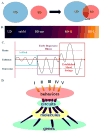Distinguishing between unipolar depression and bipolar depression: current and future clinical and neuroimaging perspectives
- PMID: 22784485
- PMCID: PMC3494754
- DOI: 10.1016/j.biopsych.2012.06.010
Distinguishing between unipolar depression and bipolar depression: current and future clinical and neuroimaging perspectives
Abstract
Differentiating bipolar disorder (BD) from recurrent unipolar depression (UD) is a major clinical challenge. Main reasons for this include the higher prevalence of depressive relative to hypo/manic symptoms during the course of BD illness and the high prevalence of subthreshold manic symptoms in both BD and UD depression. Identifying objective markers of BD might help improve accuracy in differentiating between BD and UD depression, to ultimately optimize clinical and functional outcome for all depressed individuals. Yet, only eight neuroimaging studies to date have directly compared UD and BD depressed individuals. Findings from these studies suggest more widespread abnormalities in white matter connectivity and white matter hyperintensities in BD than UD depression, habenula volume reductions in BD but not UD depression, and differential patterns of functional abnormalities in emotion regulation and attentional control neural circuitry in the two depression types. These findings suggest different pathophysiologic processes, especially in emotion regulation, reward, and attentional control neural circuitry in BD versus UD depression. This review thereby serves as a call to action to highlight the pressing need for more neuroimaging studies, using larger samples sizes, comparing BD and UD depressed individuals. These future studies should also include dimensional approaches, studies of at-risk individuals, and more novel neuroimaging approaches, such as connectivity analysis and machine learning. Ultimately, these approaches might provide biomarkers to identify individuals at future risk for BD versus UD and biological targets for more personalized treatment and new treatment developments for BD and UD depression.
Copyright © 2013 Society of Biological Psychiatry. Published by Elsevier Inc. All rights reserved.
Figures

Comment in
-
Toward a systems biology of mood disorder.Biol Psychiatry. 2013 Jan 15;73(2):107-8. doi: 10.1016/j.biopsych.2012.10.009. Biol Psychiatry. 2013. PMID: 23245950 No abstract available.
References
-
- Hirschfeld RM, Vornik LA. Bipolar disorder--costs and comorbidity. Am J Manag Care. 2005;11:S85–90. - PubMed
-
- WHO. The global burden of disease: 2004 update. Geneva, Switzerland: 2008.
-
- Goodwin FK, Jamison KR. Manic-depressive illness: bipolar disorders and recurrent depression. 2. New York, N.Y: Oxford University Press; 2007.
-
- Hirschfeld RM, Lewis L, Vornik LA. Perceptions and impact of bipolar disorder: how far have we really come? Results of the national depressive and manic-depressive association 2000 survey of individuals with bipolar disorder. J Clin Psychiatry. 2003;64:161–174. - PubMed
-
- Baethge C, Tondo L, Bratti IM, Bschor T, Bauer M, Viguera AC, et al. Prophylaxis latency and outcome in bipolar disorders. Can J Psychiatry. 2003;48:449–457. - PubMed
Publication types
MeSH terms
Grants and funding
LinkOut - more resources
Full Text Sources
Other Literature Sources
Medical
Miscellaneous

